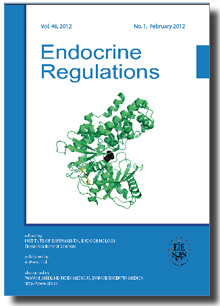Journal info
|
||
Select Journal
Journals
Bratislava Medical Journal Endocrine Regulations 2015 2014 2013 2012 2011 2010 2009 2008 2007 2006 2005 2004 2003 General Physiology and Biophysics Neoplasma Acta Virologica Studia Psychologica Cardiology Letters Psychológia a patopsych. dieťaťa Kovove Materialy-Metallic Materials Slovenská hudbaWebshop Cart
Your Cart is currently empty.
Info: Your browser does not accept cookies. To put products into your cart and purchase them you need to enable cookies.
Endocrine Regulations Vol.49, No.2, p.58-67, 2015 |
||
| Title: Impact of repeated asenapine treatment on FosB/ΔFosB expression in neurons of the rat central nucleus of the amygdala: colocalization with corticoliberine (CRH) and effect of an unpredictable mild stress preconditioning | ||
| Author: Z. Majercikova, A. Kiss | ||
| Abstract: Objectives. FosB/ΔFosB expression in the central amygdalar nucleus (CeA) in response to repeated asenapine (ASE) treatment (an atypical antipsychotic used for the treatment of schizophrenia) was studied in normal rats and rats preconditioned with chronic unpredictable variable mild stress (CMS). The goal of this study was to reveal whether repeated ASE treatment for 14 days may: 1) induce FosB/ΔFosB expression in the amygdala, 2) activate CRH-synthesizing neurons in the CeA, and 3) interfere with 21 days lasting concomitant CMS preconditioning. Methods. Four groups of animals were studied: controls and ASE-, CMS-, and CMS+ASE-treated ones. CMS consisted of the restrain, social isolation, crowding, swimming, and cold and lasted 21 days. The ASE and CMS+ASE groups were from the 7th day of the experiment treated with ASE (0.3 mg/kg, subcutaneously - s.c.) twice a day, i.e. together for 14 days. Controls and CMS groups were treated with saline (300 µl/rat, s.c.) twice a day for 14 days. All the animals were sacrificed on the 22nd day, i.e. 16-18 hours after the last treatments. Single FosB/ΔFosB, FosB/ΔFosB colocalizations with CRH, and CRH immunolabeled perikarya were investigated in the CeA using a combined light and fluorescent immunohistochemistry. Results. The distribution aspect of the black FosB/ΔFosB profiles was homogeneous over the whole CeA and no significant differences in the number of FosB/ΔFosB profiles between the individual groups of the rats really occurred. The level of colocalization pattern of FosB/ΔFosB in CRH perikarya was also very similar between the individual groups and in each case it reached approximately 10% of double-labeling. No differences were also seen in the number of CRH immunolabeled perikarya. The density of CRH nerve projections within the CeA was very alike in the individual groups of animals investigated. Conclusions. The study provides a new anatomical/functional finding about the lack of the stimulatory effect of the repeated ASE treatment on the expression of FosB/ΔFosB, FosB/ΔFosB/CRH colocalizations, and CRH immunolabeled perikarya number in the CeA. In addition, CMS preconditioning itself neither stimulated nor inhibited FosB/ΔFosB expression, nor altered the impact of ASE on the activity of CRH neurons in the CeA. |
||
| Keywords: asenapine, FosB/ΔFosB, CRH, immunohistochemistry, central amygdala, unpredictable mild stress, rat | ||
| Year: 2015, Volume: 49, Issue: 2 | Page From: 58, Page To: 67 | |
| doi:10.4149/endo_2015_02_58 |
||
|
Price:
22.00 €
|
||
|
|
||

